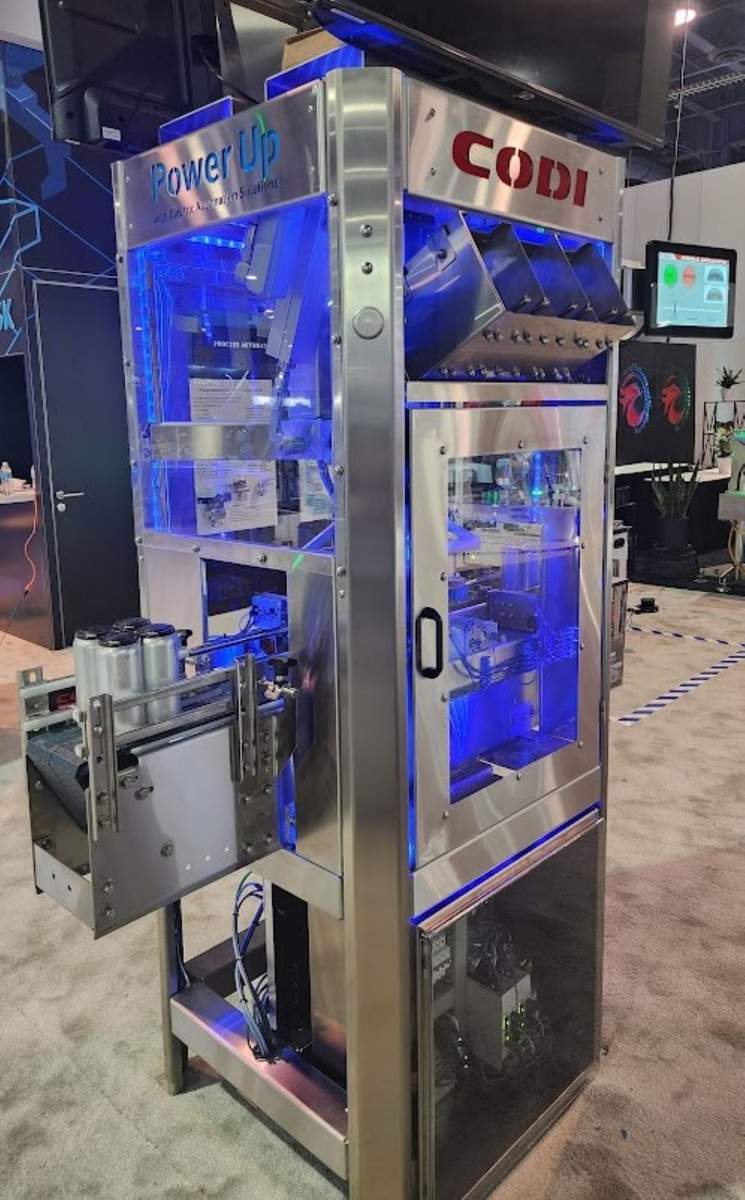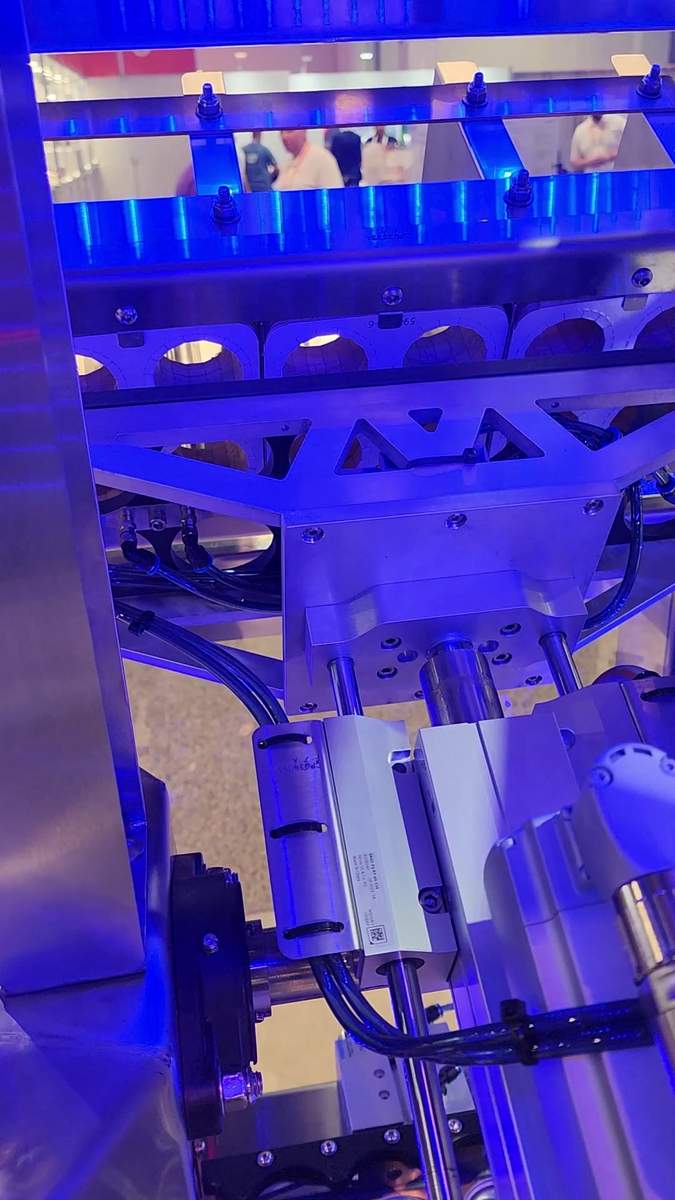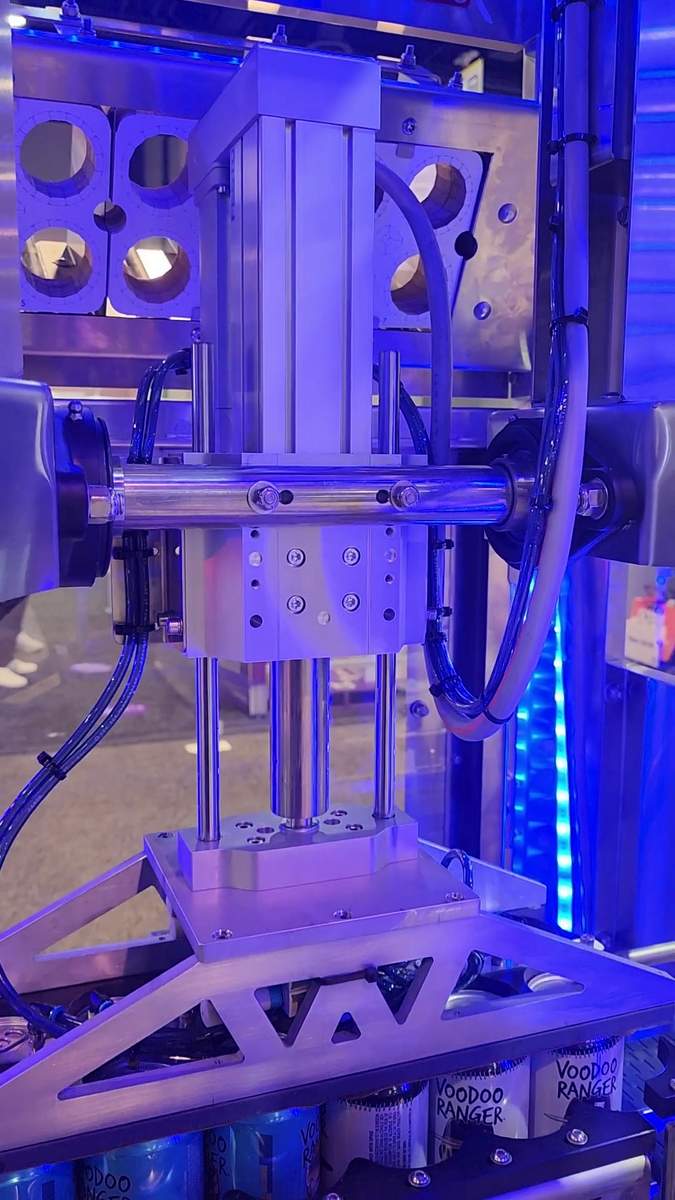
Few companies would develop a new serial machine for the packaging industry, demonstrate it met its design goals, and then jettison key components and start the R&D process over again when a fresh approach held greater promise. Yet, that is exactly what CODI Manufacturing, Littleton, Colorado, did during the development of its new can, bottle, and jug carrier applicator. CODI’s management and R&D team believe good enough performance can’t be the enemy of better performance. CODI’s philosophy is that original equipment manufacturers (OEMs) must continue to strive for the utmost in flexibility and throughput when developing a new machine and not stop until that is achieved.
The fresh approach to the carrier applicator — servo-motion-controlled automation rather than pneumatic automation — not only benefited machine performance but has also led to requests for custom solutions that incorporate the carrier applicator’s small footprint, flexibility, and throughput.
CODI Manufacturing
Over the past 30 years, CODI Manufacturing grew from an OEM developing conveying solutions to emerge as a manufacturer and innovator of food and beverage packaging solutions for small to medium-sized companies with emphasis on the craft brewing industry.
CODI innovations include a counter-pressure filling machine that gives brewers and other liquid filling operations greater flexibility in the choice of beverages, including seltzers and high carbonation drinks. The counter-pressure machine fills regardless of ambient temperature, something atmospheric filling machines cannot accomplish with carbonated beverages. The CODI system also allows for hot filling. Counter-pressure filling significantly lowers product waste compared to atmospheric fillers.
CODI produces a full line of palletizers, vacuum gripping conveyors, and various end of line solutions, including pressure-sensitive labelers. CODI has grown its custom machine building business and views custom solutions as an important growth opportunity.
A desire to develop a new serial machine
Several years ago, in sales discussions with managers at a large OEM that specialized in high-speed packaging lines processing upward of 600 cans a minute, the conversation turned to the lower throughput range of 50 to 200 cans per minute and a new development — compostable can carriers made with plant fibers. These new compostable carriers would spur market demand for automated carrier applicators for large brewers as well as small because the brewing industry, like many others, wants to lower its carbon footprint and show customers a concern for the environment.
CODI and the large OEM speculated that an automated carrier applicator for small to mid-sized breweries would need to have a small footprint, flexibility to accommodate various sized cans and a range of carrier materials, including the new fiber-based carriers, throughput of upwards of 200 cans a minute, and importantly a low price point perhaps in the $30,000 range. The large OEM encouraged CODI to explore the development of a 200 can-per-minute solution and expressed interest in purchasing those applicators. CODI saw the opportunity to develop a new serial machine to add to its lineup of standard platforms and also a machine that could serve as the foundation for custom solutions in many applications.
A good solution

The CODI R&D team focused on designing a machine that would apply carriers to 12 cans during each application cycle. Configurations would include either two six-packs or three four-packs, which conform to 4-pack, 6-pack, 12-pack, and 24 units-per-case retail norms. With cycle speeds of roughly four seconds, the machine would run between 180 to 200 cans per minute. An applicator with the compact dimensions of two feet by two feet would easily accommodate 12 cans per cycle and meet the small footprint goal.
Carrier applicators over 200 cans per minute typically have a separate carrier magazine situated next to the application process. Adding a magazine module would require additional floor space. The design team instead located an applicator magazine above the operator station, where the magazine would not expand the footprint and the applicator’s operator could easily load the magazine.
To keep costs down, pneumatics was the preferred automation. The team mounted the applicator pneumatic cylinder on a rotary fitting actuated by a second pneumatic cylinder with the sole function to extend, retract, and rotate the applicator cylinder to the up position facing the carrier magazine and down where the head faced the cans. In the up position, the applicator cylinder would extend to vacuum grip a carrier and in the down position, directly above the tops of the 12 cans, descend and apply the carriers.
There was one problem with the design — flexibility. For different can heights, the entire applicator cylinder had to be repositioned using change parts. The repositioning of the entire cylinder was necessary because pneumatic cylinders have two positions — extended and retracted. If the distance of the extend position either did not reach the short cans or expanded past the top of the tall ones, the body of the cylinder had to be manually adjusted to the correct position for the can height. Adjustments required time and labor, which reduces overall equipment effectiveness.
A better solution
Shane Loer, Industry Segment Specialist, Food/Beverage/Packaging, Festo, visited CODI and was shown the carrier applicator. “Festo is our top supplier for pneumatic and electric automation,” said Emmet Nielsen, Design Engineer, in charge of the carrier applicator R&D initiative. “We wanted to ask his opinion on the design.”
“Our sales team members are automation consultants,” Loer explained. “Even if we don’t have the right solution, we have seen it and we can point our customers in the right direction, even if it’s not a Festo solution. How we talk to and work with our customers is consultative. We are always trying to find the best solution for them.”
In the carrier applicator case, Loer suggested CODI consider a servo-electric controlled ball screw actuator rather than the pneumatic applicator cylinder. “A servo-controlled electric actuator would not require change parts when can height changed,” Loer said. “It would simply require a recipe change accomplished through a few taps on a touchscreen HMI. The other advantage of electric versus pneumatic, Loer pointed out, would be decreased cycle time leading to increased throughput. Since the actuator has infinite positions, the extend and retract distances could be minimized, which meant faster cycles because of less travel.”
Loer described how the electric actuator lowers cycle time. “After a carrier is grabbed, the electric actuator can retract while the unit is being rotated down,” he said. “It will be at the optimum distance at the end of the rotation and ready to deploy.
Whereas a pneumatic system is point to point. It needs to go all the way to the retract point. And then all the way to the extend point.”
But what about the price difference of adding servo electrics? Would the cost drive up the price of the machine and take it out of its target market? Loer worked up a parts list that showed a component increase of about 25% when using electrics rather than pneumatics. Design Engineer Nielsen observed, “Going with servo-controlled electrics would add to the cost, but the component cost is fairly negligible when you’re looking at higher throughput and greater flexibility over the machine’s lifetime.”
Jared Jones, CODI Chief Operating Officer, agreed with Nielsen, “A 25% component increase compared to the amount of functionality and the output of cans per minute with servo electric is well worth that investment.” Nielsen and Jones decided to redesign the machine. CODI ordered components directly from Festo and within a week of the order, the components arrived. Within a month, CODI transformed the carrier applicator to a servo electric with pneumatics machine.
Control architecture and key components

The electric actuator is a Festo EPCC ball screw drive powered by an EMMT-AS servo motor. To limit lateral deviation when pressing the carriers onto the cans, a Festo EAGF guide unit bolted seamlessly onto the ball screw actuator. CODI applied Festo’s new multi-protocol servo drive, the CMMT-AS. Each CMMT multi-protocol drive is compatible with EtherNet/IP, PROFIBUS, EtherCAT, and Modbus. Control engineers simply log into the drive and configure it for the Ethernet protocol they desire. The CMMT-AS and CMMT-ST series for low wattage applications are some of the most compact servo drives on the market, which saves panel space.
“Festo supplying a multi-protocol drive is a tremendous breakthrough for us,” said Jones. “We supply equipment to pretty much everybody, which means we must work with the communication protocol the customer specifies. We source only one drive to cover all the major vendors. It’s a huge inventory and commissioning advantage for us, not to mention CMMT drives are in stock and ready to ship, which eliminates supply chain uncertainty.”
CODI opted for the Festo new generation of decentralized I/O system CPX-AP-I that offers backplane speed communication and a single IP address for a valve manifold, I/O, and IO-Link components. A single IP address for valve manifold and I/O reduced commissioning time and enhanced carrier applicator control, especially with IO-Link capabilities. All the components appear to the controls engineer as residing within a single valve terminal. CPX-AP-I modules are plug and play for less wiring and faster installation.
CODI specified a CPX-AP-I compliant MPA-L valve manifold. The MPA-L is a flexible, decentralized, compact, and lightweight automation system with an IP65/IP67 rating for machine mounting. It not only saves panel space but also improves performance by locating the valves closer to the actuators. The CPX-AP-I iteration of the MPA-L valve manifold consists of a bus interface and a second module to add capabilities and capacity. MPA-L controls vacuum gripping, the DSNU round body cylinder for rotary motion, and other components. Rotary motion could also be automated by a ball screw actuator if the customer desired additional electrics and reduced pneumatics on the applicator.
A Festo CPX-E Codesys PLC controls all the Festo components and third party I/O. CODI specified a new generation HMI, the Festo IP67 rated CDPX (Part# 8155221) for on machine mounting at the operator station for easy operator access. Digital input and output modules, power supply, pressure sensor, vacuum generator, proximity switch, shut-off valves, and filter regulator round out the key Festo automation components.
Surprising customer interest
CODI displayed the carrier applicator at Pack Expo 2023 and, besides positioning it as a can carrier applicator, the CODI team emphasized the company’s custom machine building capabilities. Attendees told the CODI booth team that a simple, small footprint machine like the carrier applicator would be valuable in their operation and asked about custom solutions. Leads from Pack Expo attendees poured in.
CODI Chief Operating Officer Jones observed, “Prospects at the show recognized this little machine offered a lot of functionality in a small footprint and at an affordable price. I think for the first time at a large trade show attendees recognized CODI’s custom machine capabilities. This ‘little machine that could’ gave CODI a serial machine and a new entry point into the custom market.”
Jones said that the control architecture, including decentralized I/O, choice of quality components including multi-protocol drives, and foundation of electric automation will make customization faster and more cost effective for CODI.
“We want to help bring custom ideas to life and, with today’s technology and the right partners, CODI is in an excellent position to succeed. I’m proud that we did not stop with ‘good enough’ and strove for ‘better’.”
Steve Sterling is a business writer specializing in automation technology.





Leave a Reply
You must be logged in to post a comment.